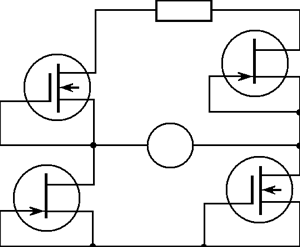Radiation sensitive detector based on field-effect transistors
DOI:
https://doi.org/10.3103/S0735272717090035Keywords:
radiation detector, field-effect transistor, bridge circuit, radiation sensitivity, drain saturation currentAbstract
The possibility of developing radiation detectors based on field-effect transistors (FET) is investigated. Transistor saturation current is chosen as an informative parameter for modeling. Experimental results show that the drain saturation current of the FET with p-n junction as a gate is decreasing after irradiation. In metal-oxide-semiconductor (MOS) FETs during radiation-induced defect formation two effects are competing, therefore the result of radiation influence is highly dependent on the electro-physical properties of transistors before irradiation and on the absorbed radiation dose. It is shown that saturation current increases with absorbed radiation dose for all the transistors with low electron concentration in a channel above certain levels of absorbed radiation. While the opposite effect is observed for high electron concentration in a channel, i.e. the saturation current drops. Obtained dependences of the drain saturation current of FET on the irradiation dose facilitated development of simple detector design for low levels of radiation. The bridge circuit is used in the radiation sensor to minimize the effect of temperature fluctuations. The sensitivity of the detector is enhanced several times with the help of two pairs of FETs with the opposite sign of radiation sensitivity.References
- ANDJELKOVIĆ, M.S.; RISTIĆ, G.S. Current mode response of phototransistors to gamma radiation. Radiation Measurements, v.75, p.29-38, 2015. DOI: https://doi.org/10.1016/j.radmeas.2015.03.005.
- TOMIMASU, T.; YAMAZAKI, T. Junction-FET dosimeter. J. Appl. Phys., v.47, n.4, p.1732-1735, 1976. DOI: http://dx.doi.org/10.1063/1.322763.
- MARTINEZ-GARCIA, M.S.; SIMANCAS, F.; РALMA, A.J.; LALLENA, A.M.; BANQUERI, J.; CARVAJAL, M.A. General purpose MOSFETs for the dosimetry of electron beams used in intra-operative radiotherapy. Sensors and Actuators A: Physical, v.210, p.175-181, 2014. DOI: https://doi.org/10.1016/j.sna.2014.02.019.
- PEJOVIC, M.M. P-channel MOSFET as a sensor and dosimeter of ionizing radiation. Facta Universitatis, Series: Electronics and Energetics, v.29, n.4, p.509-541, 2016. DOI: https://doi.org/10.2298/FUEE1604509P.
- RISTIĆ, G.S.; ANDJELKOVIĆ, M.; SAVOVIĆ, S. The isochronal annealing of irradiated n-channel power VDMOSFETs. Nuclear Instruments and Methods in Physics Research Section B: Beam Interactions with Materials and Atoms, v.366, p.171-178, 2016. DOI: https://doi.org/10.1016/j.nimb.2015.11.003.
- WANG, YING; XIANG, ZHI-QIANG; HU, HAI-FAN; CAO, FEI. Feasibility study of semifloating gate transistor gamma-ray dosimeter. IEEE Electron Device Letters, v.36, n.2, p.99-101, 2015. DOI: https://doi.org/10.1109/LED.2014.2379674.
- ARAR, D.; DJEFFAL, F.; BENTRCIA, T.; CHAHDI, M. New junctionless RADFET dosimeter design for low-cost radiation monitoring applications. Physica Status Solidi C, v.11, n.1, p.65-68, 2014. DOI: http://doi.org/10.1002/pssc.201300146.
- VIKULIN, I.M.; STAFEEV, V.I. Physics of Semiconductor Devices [in Russian]. Moscow: Radio i Svyaz’, 1990.
- KULAKOV, V.M.; SHAHOVTSOV, V.I.; ET. AL. Effect of Ionizing Radiation on Electronic Products [in Russian]. Moscow: Sov. Radio, 1980.
- VIKULIN, I.M.; KURMASHEV, S.D.; VEREMYOVA, А.V.; SOFRONKOV, А.N. Bridge sensors based on field-effect transistors. Naukovi pratsi ONAZ im. O. S. Popova, n.2, p.18-23, 2013. URI: https://biblio.onat.edu.ua/handle/123456789/81.
- VIKULIN, I.M.; KURMASHEV, S.D.; VIKULINA, L.F.; STAFEEV, V.I. Frequency-output sensors-transducers based on unijunction transistors. J. Commun. Technol. Electron., v.59, n.3, p.275, 2014. DOI: https://doi.org/10.7868/S0033849414030140.
- RISTIĆ, G.S.; ANDJELKOVIĆ, M.S.; JAKŠIĆ, A.B. The behavior of fixed and switching oxide traps of RADFETs during irradiation up to high absorbed doses. Appl. Radiation Isotopes, v.102, p.29-34, 2015. DOI: https://doi.org/10.1016/j.apradiso.2015.04.009.

Downloads
Published
2017-09-21
Issue
Section
Research Articles

